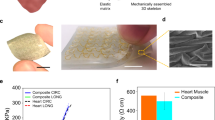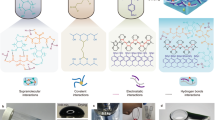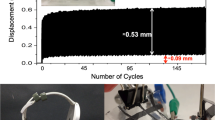Abstract
Electroactive polymers (EAPs) can behave as actuators, changing their shape in response to electrical stimulation. EAPs that are controlled by external electric fields—referred to here as field-type EAPs—include ferroelectric polymers, electrostrictive polymers, dielectric elastomers and liquid crystal polymers1,2,3,4,5,6. Field-type EAPs can exhibit fast response speeds, low hysteresis1,2,3,4,5,6,7,8 and strain levels far above those of traditional piezoelectric materials4,5,6,9,10, with elastic energy densities even higher than those of piezoceramics4,5,9,10,11. However, these polymers also require a high field (>70 V µm-1) to generate such high elastic energy densities (>0.1 J cm-3; refs 4, 5, 9, 10). Here we report a new class of all-organic field-type EAP composites, which can exhibit high elastic energy densities induced by an electric field of only 13 V µm-1. The composites are fabricated from an organic filler material possessing very high dielectric constant dispersed in an electrostrictive polymer matrix. The composites can exhibit high net dielectric constants while retaining the flexibility of the matrix. These all-organic actuators could find applications as artificial muscles, ‘smart skins’ for drag reduction, and in microfluidic systems for drug delivery1,2,3,12.
This is a preview of subscription content, access via your institution
Access options
Subscribe to this journal
Receive 51 print issues and online access
$199.00 per year
only $3.90 per issue
Buy this article
- Purchase on Springer Link
- Instant access to full article PDF
Prices may be subject to local taxes which are calculated during checkout



Similar content being viewed by others
References
Bar-Cohen, Y. (ed.) Electroactive Polymer Actuators as Artificial Muscles (SPIE, Bellingham, WA, 2001)
Zhang, Q. M., Furukawa, T., Bar-Cohen, Y. & Scheinbeim, J. (eds) Electroactive Polymers (MRS Symp. Proc. Vol. 600, MRS, Warrendale PA, 1999)
Nalwa, H. (ed.) Ferroelectric Polymers (Marcel Dekker, New York, 1995)
Zhang, Q. M., Bharti, V. & Zhao, X. Giant electrostriction and relaxor ferroelectric behavior in electron-irradiated poly(vinylidene fluoride-trifluofoethylene) copolymer. Science 280, 2101–2104 (1998)
Pelrine, R., Kornbluh, R., Pei, Q. & Joseph, J. Highspeed electrically actuated elastomers with strain greater than 100%. Science 287, 836–839 (2000)
Lehmann, W. et al. Giant lateral electrostriction in ferroelectric liquid-crystalline elastomers. Nature 410, 447–450 (2001)
Baughman, R. H. et al. Carbon nanotube actuators. Science 284, 1340–1344 (1999)
Osada, Y., Okuzaki, H. & Hori, H. A polymer gel with electrically driven motility. Nature 355, 242–244 (1992)
Cheng, Z.-Y. et al. Electrostrictive poly(vinylidene fluoride-trifluoroethylene) copolymers. Sens. Actuat. A 90, 138–147 (2001)
Xu, H. et al. Ferroelectric and electromechanical properties of poly(vinylidene-fluoride–trifluoroethylene–cholorotrifluoroethylene) terpolymer. Appl. Phys. Lett. 78, 2360–2362 (2001)
Huber, J. E., Fleck, N. A. & Ashby, M. F. The selection of mechanical actuators based on performance indices. Proc. R. Soc. Lond. A 453, 2185–2205 (1997)
Dario, P., Carrozza, M., Benvenuto, A. & Menciassi, A. Micro-systems in biomedical applications. J. Micromech. Microeng. 10, 235–244 (2000)
McCrum, N., Read, B. E. & Williams, G. Anelastic and Dielectric Effects in Polymeric Solids (Dover, New York, 1967)
Moulson, A. & Herbert, J. Electroceramics (Chapman & Hall, London, 1995)
Cross, L. E. Ferroelectric ceramics: materials and application issues. Ceram. Trans. 68, 15–55 (1996)
Safari, A., Sa-gong, G., Giniewicz, J. & Newnham, R. Composite piezoelectric sensors. Proc. 21st Univ. Conf. Ceram. Sci. 20, 445–455 (1986)
Bao, Z., Lovinger, A. & Dodabalapur, A. Highly ordered vacuum-deposited thin films of metallophthalocyanines and their application in field-effect transistors. Adv. Mater. 9, 42–45 (1997)
Tominaga, T., Hayashi, K. & Toshima, N. Accelerated hole transfer by double-layered metallophthalocyanine thin film for effective electroluminescence. Appl. Phys. Lett. 70, 762–763 (1997)
Nalwa, H. S., Dalton, L. & Vasudevan, P. Dielectric properties of copper-phthalocyanine polymer. Eur. Polym. J. 21, 943–947 (1985)
Phougat, N., Vasudevan, P. & Nalwa, H. Handbook of Low and High Dielectric Constant of Materials and Their Applications Ch. 8 (ed. Nalwa, H.)) (Academic, London, 1999)
Vijayakumar, P. & Pohl, H. A. Giant polarization in stable polymeric dielectrics. J. Polym. Sci. Poly. Phys. 22, 1439–1451 (1984)
Gould, P. D. Structure and electrical conduction properties of phthalocyanine thin films. Coord. Chem. Rev. 156, 237–274 (1996)
Landau, L. D. & Lifshitz, E. M. Electrodynamics of Continuous Media (Pergamon, Oxford, 1970)
Newnham, R., Sundar, V., Yimmirun, R., Su, J. & Zhang, Q. M. Electrostriction in dielectric materials. Ceram. Trans. 88, 15–39 (1998)
Damjanovic, D. Logarithmic frequency dependence of the piezoelectric effect due to pinning of ferroelectric-ferroelastic domain walls. Phys. Rev. B 55, R649–R652 (1997)
Su, J., Zhang, Q. M. & Ting, R. Y. Space-charge-enhanced electromechanical response in thin-film polyurethane elastomers. Appl. Phys. Lett. 71, 386–388 (1997)
Hayashi, K., Kawato, S., Fujii, Y., Horiuchi, T. & Matsushige, K. Effect of applied electric field on the molecular orientation of epitaxially grown organic films. Appl. Phys. Lett. 70, 1384–1386 (1997)
Ai-Aliak, H., Illingsworth, J., Brinkman, A., Russell, G. J. & Woods, J. The effects of donor dopant concentration on the grain boundary layer characteristics in n-doped BaTiO3 ceramics. J. Appl. Phys. 64, 6477–6482 (1998)
Achar, B. N., Fohlen, G. G. & Parker, J. A. Phthalocyanine polymers. II Synthesis and characterization of some metal phthalocyanine sheet oligomers. J. Polym. Sci. Polym. Chem. 20, 1785–1790 (1982)
Su, J., Moses, P. & Zhang, Q. M. A piezoelectric bimorph based dilatometer for field induced strain measurement in soft and thin free standing polymer films. Rev. Sci. Instrum. 69, 2480–2484 (1998)
Acknowledgements
This work was supported by the National Institutes of Health, the Office of Naval Research, and Defense Advanced Research Projects Agency.
Author information
Authors and Affiliations
Corresponding author
Ethics declarations
Competing interests
The authors declare that they have no competing financial interests.
Rights and permissions
About this article
Cite this article
Zhang, Q., Li, H., Poh, M. et al. An all-organic composite actuator material with a high dielectric constant. Nature 419, 284–287 (2002). https://doi.org/10.1038/nature01021
Received:
Accepted:
Issue Date:
DOI: https://doi.org/10.1038/nature01021
This article is cited by
-
Highly stretchable and self-healing SEBS-PVDF composite films for enhanced dielectric elastomer generators
Journal of the Korean Ceramic Society (2024)
-
Influence of h-BN Concentration on the Development of PVDF-HFP/TiO2/h-BN Nanocomposite Films for Electroadhesive Applications
Journal of Electronic Materials (2024)
-
Electro-thermal actuation in percolative ferroelectric polymer nanocomposites
Nature Materials (2023)
-
Polymer actuation using a Joule-heating-induced ferroelectric phase transition
Nature Materials (2023)
-
Soft Manipulator for Soft Robotic Applications: a Review
Journal of Intelligent & Robotic Systems (2023)
Comments
By submitting a comment you agree to abide by our Terms and Community Guidelines. If you find something abusive or that does not comply with our terms or guidelines please flag it as inappropriate.



